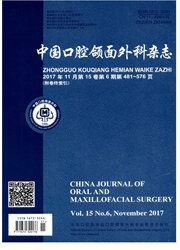

 中文摘要:
中文摘要:
目的:探索建立人口腔鳞癌PBL-SCID鼠嵌合模型,评价4-1BBL在人口腔鳞癌PBL-SCID嵌合模型肿瘤免疫中的作用。方法:SCID鼠右背部皮下注射5×106(0.2 mL)Tca8113细胞。成瘤后,尾静脉注射anti-asialo-GML多抗,随机分为4组,第①组为对照组,不给予成瘤小鼠免疫重建,第②组给予成瘤小鼠免疫重建,第③组给予成瘤小鼠免疫重建+含有空载体的腺病毒做肿瘤内注射,第④组给予成瘤小鼠免疫重建+含有4-1BBL基因的腺病毒做肿瘤内注射。第②、③、④组小鼠腹腔注射健康志愿者外周血淋巴细胞3×107(0.5 mL),第①组腹腔注射0.5 mL1640培养基。每周记录各组小鼠的成瘤情况,免疫重建后,第2、7周取鼠血,用ELISA法测定人IgG含量。小鼠处死后,比较各组小鼠体重及肿瘤、脾脏的重量。RT-PCR检测4-1BBL基因在瘤体内的表达,HE染色检测肿瘤及脾脏生长情况。结果:模型成瘤率为100%,成瘤潜伏期12~18 d。免疫重建后第2、7周时人口腔癌PBL-SCID嵌合组小鼠血中人IgG分别达71.8μg/mL、136.9μg/mL。免疫重建及转染4-1BBL基因组小鼠,肿瘤生长受到明显抑制(P〈0.01)。RT-PCR证明4-1BBL基因在瘤体内充分表达,冰冻切片HE染色见肿瘤生长、脾脏有大量淋巴细胞浸润。结论 :SCID小鼠皮下注射口腔鳞癌细胞、腹腔注射人淋巴细胞,可建立人口腔鳞癌PBL-SCID嵌合模型,经腺病毒转染4-1BBL基因后,可显著提高宿主对瘤体的抑制作用。
 英文摘要:
英文摘要:
PURPOSE:To establish OSSC hu-PBL-SCID chimeric model and evaluate the tumor immune effect of 4-1BBL on the mouse model.METHODS:Give the SCID mice 5×106(0.2 mL) Tca8113 cells on the right back by subcutaneous injection.Injected anti-asialo-GML antibody from the tail vein after the tumor formed and divided into four groups randomly: Group 1 were not reconstructed tumor immune as a reference group.Group 2 were reconstructed tumor immune only.Group 3 were reconstructed tumor immune and injected adenovirus containing empty vector into the tumor.Group 4 were reconstructed tumor immune and injected adenovirus containing 4-1BBL into the tumor at the same time.Then,group 1 were injected 0.5mL 1640 medium into intraperitoneal,and group 2,3,4 were injected 3×107(0.5 mL) lymphocytes of healthy volunteers at the same time.Recording the growth of the tumor weekly,and determined the humam IgG in the mice's blood at the second and the seventh week after the immune reconstruction by ELISA.Comparing the weight of the mice,the tumor and the spleen after the mice were killed.Determined the expression of 4-1BBL by PR-PCR,and determined the growth of the tumor and the spleen by HE.RESULTS:The tumorigenesity rate was 100% and the latency time was 12 to 18 days.At the second and seventh week after the immune reconstruction,the content of human IgG in Group 4 was 71.8μg/mL and 136.9μg/mL respectively,the growth of the tumor remarkably inhibited(P0.01),and full expression of the 4-1BBL gene in the tumor was proved by RT-PCR,and pathological examination showed tumor growing and a large number of lymphocytes infiltrated the spleen.CONCLUSION:The hu-PBL-SCID OSCC chimeric model can be successfully established by combination of subcutaneous injection oral cancer cells and intraperitoneal injection human peripheral blood monocytes to the SCID mice.And the host's capacity of tumor inhibition can increase significantly after transfection.Supported by National Natural Science Foundation of China(30672335).
 同期刊论文项目
同期刊论文项目
 同项目期刊论文
同项目期刊论文
 期刊信息
期刊信息
